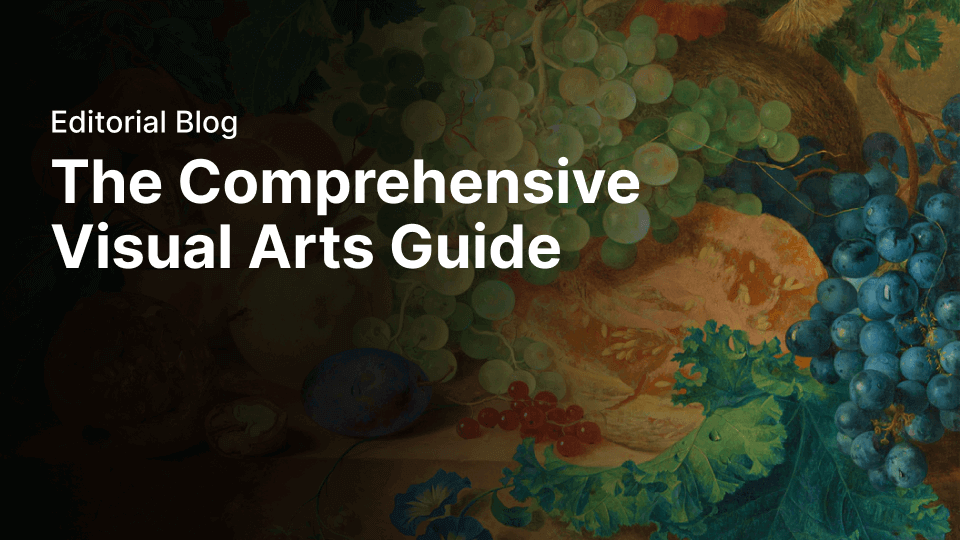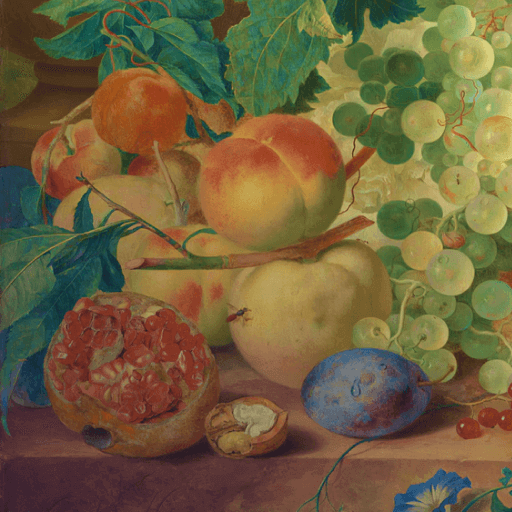When we hear the term "visual arts," we generally think of grand and historical painters like Vincent van Gogh, Pablo Picasso, and Auguste Rodin. But the phrase actually encompasses a wide range of mediums, such as sculpture, film-making, architecture, photography, and painting.
While disciplines like textile arts, conceptual art, and performing arts aren't generally defined as visual arts, they certainly incorporate qualities of visual arts. Then there are the applied arts—which fall under visual arts—such as graphic design, industrial design, and fashion design.
.jpg)
We tend to be quite narrow in our understanding of visual arts.
Certainly, visual culture was once conceptually limited to the big names in fine art. However, the efforts of key figures in the 20th century broadened our understanding.
Simply put, any artistic or creative production that relies on our eyes to be appreciated is likely to fall under the visual arts umbrella term.
Today, we can enjoy a phenomenal span of visual art forms and entertainment, and there is a wide range of academic and career options for those passionate about art in general. One can take courses in art history, join the ranks of speculative design majors, or even examine the creative possibilities of alternative history.
Covering the full, almost unfathomable span encompassing the visual arts would take a thick academic book’s worth of content. For simplicity’s sake, we’ll mostly focus on painting, photography, cinema, and graphic design.
We'll look at some of the most influential figures in European art history, like Salvador Dalí, Paul Cézanne, and Leonardo da Vinci. We'll also guide you on the best way to get started with visual arts and how you can turn your space into your personal studio with your preferred visual medium.
Jumpstart your ideas with Linearity Curve
Take your designs to the next level.
Visual arts definition
As the term suggests, the visual arts are appreciated visually, through one's eyes. There are different types of visual art, including film-making, sculpture, painting, and photography.
The history of visual arts
The history of art spans many thousands of years, with the earliest visual arts dating back to prehistoric times. A typical art history program will take you through the entire progression of human development, from the Stone Age to today's contemporary art.
The first forms of visual art
Human beings have been creating art long before we could speak or wear clothes.
The Lascaux and Chauvet caves contain some of the most important prehistoric art ever created. Archeologists found fantastic depictions of deer, bison, horses, and cattle in these caves that were made around 32,000 years ago!

Back then, humans were primarily concerned with painting animals and hunting scenes, but there are instances of human figures and depictions of what seems to be families or hunter-gatherer groups.
Fast-forward tens of thousands of years to the ancient Egyptians' tombs, and we find more structured human figure paintings. In Ramses II's great temple, you'll find a magnificent piece showing his queen Nefertari adorned by the god, Isis.
On the other side of the world, the ancient Greeks were revolutionizing the cultural contexts of visual culture, but sadly much of these contributions were lost to time. One of the best-preserved examples of ancient art is the Hellenistic depictions of the Fayum mummy portraits.
From the Renaissance to modern times
While the Late Middle Ages' European visual culture is often thought of as limited to illuminated manuscripts, the buildings that housed these religious works and the sculptures that shared their cavernous interiors were completely epic.
Gothic architecture and its imposing cathedrals loomed over France, Spain, and Germany, with “The High Gothic Years” spanning the mid-12th to 13th centuries. Regardless of such architectural feats, the ensuing Rennaissance is considered an even dearer artistic treasure trove for art history majors.
Giotto laid this period’s foundations during the Late Middle Ages, an artist that was fundamental to the Gothic or Proto-Rennaissance period. Giotto’s efforts led to the greats of the Renaissance, where legendary masters like Michelangelo, Botticelli, Donatello, Raphael, and Leonardo da Vinci reigned between the 14th and 17th centuries.

The 17th century was dominated by Dutch masters like Rembrandt, while the first major post-Rennaissance movement was the Italian-obsessed Baroque, which included key artists like Caravaggio. The artistic practice changed almost completely with the 19th-century Impressionism movement.
French mavericks like Paul Cézanne, Pierre-Auguste Renoir, and Claude Monet threw many of the academic standards of visual art out the window and developed their own freely brushed style into play. Artists of this time were more interested in capturing the natural beauty of the outside world, rather than the staged and stuffy studio.
Our short seminar on art history ends with the 20th century when contemporary art practice was taking off. The late 19th century enjoyed revolutionaries like Norwegian artist Edvard Munch and his works like The Scream. The visual arts then took a darker and more emotive turn with the German expressionist movement and its key artists like Erich Heckel and Ernst Ludwig Kirchner.

While the German expressionists were getting moody with their artistic practice, their cubist counterparts like Georges Braque and Pablo Picasso were fixated on the space and volume of structures. These abstract compositions would influence a more contemporary art practice like the surrealism movement of the 1920s, headed by eccentric figures like Salvador Dali and René Magritte.
That's it for our brief critical study and art history program! There are plenty of artist books for you to pore through and enjoy a better appreciation of the traditional visual arts.
We'd also recommend that you look at a few non-Western contexts, like the silk masterpieces of ancient Chinese artists or the creative artistic practice of the Kuba people. Regardless of your field of interest, there are plenty of superb courses in art history that you can take online.
Visual culture today includes many cultural contexts and a wide range of forms. With the development of photographic technologies, film, and other types of advanced production came many of the sensational visual arts that we enjoy today.
Get creative with our ready-to-use templates.
Linearity Curve offers templates for every social media platform and various use case templates for posters, business cards, slides, app store screenshots, and more.
Some key types of visual arts to know
Defining the main types of visual arts is never easy, even if many art history majors will tell you what an accepted form is and what is part of alternative history.
Certainly, there are many cases of artistic production and contemporary art practices that barely received department approval from the most elitist department chair.
Critical study aside, we would now like to take you through a few of the most influential and successful forms of artistic production. Since we've already covered painting, we'll give some other historical and current media practices the spotlight.
Photography
Photography is a technique where light is captured using a camera, either with film or digital technology.
Although photography is not strictly part of the seven forms of art, it is a broader member of the visual arts bracket.
While photography is one of the most accessible current media practices, given that most of us have sophisticated cameras in our smartphones, the art of capturing a piece of the world was once quite a difficult and novel task.
Take Joseph Nicéphore Niépce, for example, who digital film production students will recognize as having taken the first photograph in 1826 (or 1827, depending on who you trust). This incredibly grainy and barely recognizable snap of a quaint town scene is called “View from the Window at Le Gras.”

While Niépce was probably quite proud of himself for this technological breakthrough, he might not have imagined that one day we'd be taking pictures of other galaxies. However, as far as the history of photography goes, speculative design minors are indebted to Niépce for his ingenuity.
Photography as a craft took many decades of development before it became functional. Niépce worked with Loui Daguerre to create the daguerreotype, a progenitor for modern film.
A daguerreotype took 15 minutes to capture enough light to take a snap and would later be replaced by emulsion plates. The entire process was costly, and photography was largely restricted to professionals or the upper classes.
It wasn't until the 1880s that George Eastman, the founder of Kodak, created a box camera that looked more similar to what we understand cameras to be today. These early Kodak cameras held roll film that allowed the user to take 100 shots.

The camera continued to evolve throughout the 20th century, and Asahi and Nikon introduced their individual SLR-type cameras that gave photographers greater control over their shots.
Polaroid's Model 95 allowed users to create instant images following the mid-twentieth century. However, the history of photography took a turning point in the 1980s and 1990s, when Kodak's advanced production techniques created digital photography and DSLR cameras.
Today, the most affordable point-and-shoot devices vastly outperform Niépce's first cameras as a comparative study, and modern smartphones allow adults and preschool children alike to take high-quality photographs.
The history of cinema
A night at the movies is a magical experience, and film is among the most widely appreciated forms of contemporary art practices. From American World War II propaganda films to modern action blockbusters and indie films, the history of cinema is incredibly rich and colorful.
But how did we first turn static photographs into full-motion spectacles? Our next critical study begins with an invention that would blow Leonardo Da Vinci himself away: the Kinetoscope.

The Edison Company created this ingenious (if not bulky) contraption in 1891 that allowed a single viewer to peer inside and watch a short animated preview.
By 1914, the nascent film industry began taking off in Europe. Our modern understanding of films bloomed in the early 20th century, and filmmakers told actual stories with astounding visual panache.
Some of the earliest films include classics like With Our King and Queen Through India, which had an impressive runtime of more than two hours.
Directors would only add audio to films in the 1930s, and color began slowly trickling into feature presentations as the "Golden Age of Hollywood" began. The director was the new American artist. Closer to the mid-twentieth century, cinema became a staple form of entertainment for families worldwide.
A seminar in art history might spend some time covering the importance of the aspect ratio in art and graphic design. Cinematographers were equally concerned with adjusting the measurements of their films to ensure that viewers enjoyed the most immersive experiences possible (with the relevant film department approval, of course).
While directors experimented with and perfected their aspect ratios, technology was rapidly advancing as the 20th century drew to a close. Digital mediums were steadily replacing traditional, physical film, and today most movies are captured using digital cameras, with film being a novelty.
.jpg)
In our modern culture, films are universally consumed, and we have access to non-Western contexts that older generations were sadly cut off from. You can now enjoy an endless library of blockbusters, documentaries, and indie films, from Andrei Tarkovsky's mind-bending sci-fi to the Marvel Cinematic Universe's IMAX spectacles.
Graphic design
Graphic design is often understood as a commercial practice, where graphic designers create illustrations and visuals to accompany advertising and marketing copy.
However, graphic design is an art form in itself. Modern graphic designers will often work with design tools like Linearity Curve (formerly Vectornator) or Illustrator to create all kinds of amazing visuals.
.png)
Most art historians agree that the invention of the printing press in 1439 marked the starting point for graphic design as an industry—many hundreds of years before the advent of digital technology.
But visual communication was inherent to humans long before this breakthrough came to pass. The French neolithic cave paintings discussed earlier are the earliest example of humans trying to tell each other things through imagery.
Humanity would soon become more sophisticated with their pictures, and the first recorded written language, that of the Sumerians, was logographic, meaning that they used icons to represent words.
Unleash Your Creativity with Illustration
Explore a world where art meets functionality. Discover how our illustration tools can transform your creative ideas into stunning visuals.
People were gradually refining their ability to communicate complicated concepts through visuals, a skill that would define graphic design. Today, we can look at a small cross, and thousands of years of religious significance and history spring to mind, while a sign with a spooky skull on it will stop us from walking into perilous danger.
Closer to the common era, we have China to thank for the first printing processes using woodblock and wood reliefs. The next major advancement in visual communication came in the form of Medieval calligraphy, followed by the Gutenberg Press's European formalization in 1439.

With this ingenious device's Vatican department approval (and department stamp) at hand, the Western world was finally liberated from the darkness of limited literacy and information could be widely accessed and consumed.
From that point onward, the common person could communicate with a wide audience. The related technology advanced until we could finally print in color, thanks to chromolithography in the 19th century.
The Wiener Werkstätte was the first graphic design agency, and the actual term was coined in 1922. Beyond the mid-twentieth century, the digital era bloomed, and graphic design software like Adobe Photoshop was released in 1990 and more recent programs like Linearity Curve (formerly Vectornator) in 2017.
Today, anyone can dabble in graphic design thanks to how simple and accessible graphic design software like Linearity Curve (formerly Vectornator). This free and easy-to-use app allows graphic designers and people with little experience alike to create beautiful and professional-looking illustrations and graphics.
How to get started with visual arts
There are certainly many incredible paths to take if you want to get started with visual arts, whether you'd like to join your local pottery class, attend a night school art history program, or study a few of the art history majors in a leading art school.
Painting is one of the easiest ways to get started with visual art and is far more affordable and accessible than some may think.
A few masterful painting guidelines
If you would like to put the artist books and pick up a paintbrush, there are a few guidelines that we should briefly cover.
Don't mix up your palette
A palette is a standard tool for beginners and art history majors alike. Your palette should be kept neat, ordered, and consistently prepared, like anything in life.
.jpg)
A failure to order your paints can lead to colorful chaos when you can't find your needed paint.
Put things into perspective
Courses in art history generally maintain that getting your perspective right should be done before adding a single blot of paint. Simply put, perspective allows you to grasp the bigger picture of your work in progress.
It's how you establish an accurate and convincing point of view with a spatial concern. Perspective allows you to position all the objects and figures in your canvas in a realistic manner.
However, you don't need to consult speculative design majors to nail perspective, as there are plenty of online courses on the subject.
Gather your tools
You'll obviously need a few things before you start painting, like an appropriate surface to paint on, a set of brushes, and a palette (which we already mentioned).
- Surface: You don't need to splash out on a fancy canvas (unless you want to), as cardboard is a cheap and readily available medium.
- Brushes: We'd recommend a rectangle-shaped brush like a filbert, with its versatile almond-shaped tip. You can use a filbert's flat edge brush to make broad strokes. The side creates linear and thin strokes, while the tip produces the finest lines possible.
- Palette: You can use a simple board or tray for your palette, but as previously stated, make sure that you keep your paints orderly and neat. As for paints, your local hardware store should have an affordable starter kit that has all the colors you'll need for your first piece.
.jpg)
Get to grips with drawing
Drawing is one of the trickier aspects of visual arts that many people struggle with. The temptation to join a directed group study on mastering the pencil is ever-present. Still, a few techniques will help you relax and appreciate your work in progress.
.jpg)
It's important to take regular breaks while drawing, especially if you start to feel frustrated or jaded. If you glance back and forth between your reference image and drawing several times, your eyes will better establish whether you're winning or not.
Another trick is to flip your drawing 180 degrees and work upside-down. This allows your eyes to break something like a bird down into shapes rather than your broad understanding of the figure.
Experiment with mediums
While a seminar in art history will provide you with a professional understanding of the different paint types, nothing beats getting hands-on with oil, acrylic, and watercolor paints to see which works best for you.
.jpg)
- Oil paints: This medium dries slowly, meaning that you have a wider window for touchups and changes. Just remember that oil paint will never truly cure, so please be very careful when moving or storing your pieces.
- Acrylic paints: Acrylic products are generally nontoxic and are pleasingly varied so that you can land your preferred thickness, texture, and surface absorbency. Please note that acrylic binders have been known to include ammonia, which can irritate sensitive skin.
- Watercolor: You can use this type of paint to create realistically transparent natural scenes. This medium is water-soluble so that you can be moderately flexible with your finished piece. However, it can be difficult to take off once the paint stains a paper surface after sinking in.
If you find that you greatly enjoy painting (or any of the other visual art forms), there's a chance that you might want to dedicate your academic and professional life to the visual arts.
Top universities in visual arts
If you are considering reaching out to a department chair of your local art school's speculative design majors for guidance, you might want to find out which art schools are the best around. Of course, no one needs a department stamp from a leading institution to enjoy a fruitful career.
You might be wondering, what is the best art school?
Royal College of Art (RCA)
The Royal College of Art was instituted in 1837, making it the oldest art and design university in that world still in operation. It is situated in London and functions as the United Kingdom's only totally postgraduate art and design university.
Due to its prestigious status as the top Art and Design university in the world for several years running, as well as its exclusive courses, the Royal College of Art enjoys a phenomenally varied attendance with students hailing from around 60 countries across the world.
University of the Arts London (UAL)
The University of the Arts London is the runner-up to the best art school in the world and is the largest specialist art and design university in Europe. It is home to nearly 20,000 students from over 130 countries, from digital film production minors to speculative design majors.
The UAL hosts six revered fashion, art, media, and design Colleges that were established throughout the nineteenth and twentieth centuries. Department chair James Purnell serves as the current President and Vice-Chancellor of the University of the Arts London.
Rhode Island School of Design (RISD)
The Rhode Island School of Design (affectionately known as "RIZ-dee") was established in 1877 and serves as a leading art school in the United States. Around 2,300 students attend RIZ-dee annually while furthering their studio-based qualifications.
RISD's alumni include several Primetime Emmy Awards, MacArthur Genius fellowships, and Academy Awards. Most of the most successful artists in the United States' auction department were RISD undergraduates.
In conclusion
While it is impossible to sum up the history and grandeur of visual arts across the world, we hope that this article inspired you to take a greater interest in some of the mediums and fields we discussed.
We are privileged to live in a world where art and artistic expression are so readily and freely available, and you can find inspiration through casual online research and a directed group study alike.
At the very least, everyone should experience the joys of unrestrained paint splashing, the cool, slippery textures of wet clay, or the hilarious enjoyment of making a short film with your friends and a smartphone camera.
If digital is your preferred medium, one of the most straightforward ways to get into graphic design is with free and straightforward software like Linearity Curve (formerly Vectornator).
Our nifty app allows you to make incredible vector illustrations, graphic layouts, and typographic designs. Download the latest version on your Mac, iPad, or iPhone today.
Jumpstart
your ideas with
Linearity Curve
Take your designs to the next level.


Share this!
Theodore Cipolla
Theodore is a contributing writer to the Linearity Blog.





:quality(75))

:quality(75))
:quality(75))



